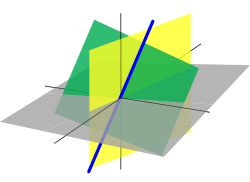
Back Lineêre algebra Afrikaans Lineare Algebra ALS Alchebra lineal AN جبر خطي Arabic Álxebra llinial AST Xətti cəbr Azerbaijani Һыҙыҡлы алгебра Bashkir Лінейная алгебра Byelorussian Лінейная альгебра BE-X-OLD Линейна алгебра Bulgarian

Linear algebra is the branch of mathematics concerning linear equations such as:
linear maps such as:
and their representations in vector spaces and through matrices.[1][2][3]
Linear algebra is central to almost all areas of mathematics. For instance, linear algebra is fundamental in modern presentations of geometry, including for defining basic objects such as lines, planes and rotations. Also, functional analysis, a branch of mathematical analysis, may be viewed as the application of linear algebra to function spaces.
Linear algebra is also used in most sciences and fields of engineering, because it allows modeling many natural phenomena, and computing efficiently with such models. For nonlinear systems, which cannot be modeled with linear algebra, it is often used for dealing with first-order approximations, using the fact that the differential of a multivariate function at a point is the linear map that best approximates the function near that point.
- ^ Banerjee, Sudipto; Roy, Anindya (2014). Linear Algebra and Matrix Analysis for Statistics. Texts in Statistical Science (1st ed.). Chapman and Hall/CRC. ISBN 978-1420095388.
- ^ Strang, Gilbert (July 19, 2005). Linear Algebra and Its Applications (4th ed.). Brooks Cole. ISBN 978-0-03-010567-8.
- ^ Weisstein, Eric. "Linear Algebra". MathWorld. Wolfram. Retrieved 16 April 2012.
© MMXXIII Rich X Search. We shall prevail. All rights reserved. Rich X Search

